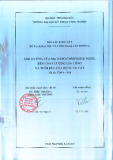
NANO EXPRESS Open Access
Synthesis and magnetic properties of
single-crystalline Na
2-x
Mn
8
O
16
nanorods
Changyong Lan
1
, Jiangfeng Gong
1,2
, Shijiang Liu
3
, Shaoguang Yang
1*
Abstract
The synthesis of single-crystalline hollandite-type manganese oxides Na
2-x
Mn
8
O
16
nanorods by a simple molten salt
method is reported for the first time. The nanorods were characterized by powder X-ray diffraction, scanning
electron microscopy, transmission electron microscopy, and a superconducting quantum interference device
magnetometer. The magnetic measurements indicated that the nanorods showed spin glass behavior and
exchange bias effect at low temperatures. The low-temperature magnetic behaviors can be explained by the
uncompensated spins on the surface of the nanorods.
Background
One dimensional (1D) nanostructures including nano-
belts, nanotubes, nanowires, and nanorods have attracted
much attention due to their fascinating physical and
chemical properties and their potential applications in
nanodevices [1,2]. Manganese oxides have a wide range
of applications such as catalysts [3], ion sieves [4], and
battery materials [5]. Much effort has been made to pre-
pare low dimensional manganese oxides nanomaterials
with various polymorphs [6-8]. As a novel Mn
3+
-Mn
4+
mixed valence system, hollandite-type compounds with
chemical formula A
x
Mn
8
O
16
(A = K, Rb, Ba, or Pb, etc.
and x≤2) have been enthusiastically pursued for their
applications in fast ionic conductors, solid state electro-
lytes, oxidation catalysts, and stable host materials
for radioactive ions from nuclear wastes [9-12]. The crys-
tal structure of the hollandite-type material is very por-
ous, including 1D 2 × 2 tunnels among rigid MnO
2
framework composed of edge-shared MnO
6
octahedra
[4,10,13]. The A ions occupy in the tunnels as guest
cations and they are easily replaced by other ions [13].
Due to the special crystal structure and the mixed
valence properties of Mn, these compounds show inter-
esting magnetic and electric properties [13-16]. The for-
mation of K
x
Mn
8
O
16
with hollandite-type structure is
very easy, since the K
+
cation is of the ideal dimension to
fit in the 2 × 2 tunnels. But the Na
+
cation is on the
small side to stabilize the 2 × 2 tunnels, thus hollandite
Na-Mn-Ocompoundishardtobeobtained[3].Na
2-
x
Mn
8
O
16
is known to have hollandite structure with
unit-cell parameters a=9.91Å,b=2.86Å,c=9.62Å
and b= 90.93° (JCPDS No. 42-1347), and the ion tunnel
of which is along b-axis. To the best of our knowledge lit-
tle information about this compound has been reported.
Here, we report the synthesis of Na
2-x
Mn
8
O
16
nanorods
by a very simple molten salt method for the first time.
Exchange bias (EB) effect is observed in the materials
with good ferromagnetic (FM)/antiferromagnetic (AFM)
interface, such as Ni
80
Fe
20
/Ir
20
Mn
80
system [17]. The EB
effect originates from the interfacial interaction between
FM and AFM materials [18]. Recently, it was reported
that 1D pure phase AFM nanomaterials exhibited EB
effect at low temperatures, such as Co
3
O
4
nanorods [19],
SrMn
3
O
6-δ
nanobelts [20], CuO nanowires [21]. Since
there is no FM layer in those materials, the EB effect in
pure 1D AFM nanomaterials is probably related to the
surface layer of the nanomaterials, which is due to the
changes in the atomic coordination form a layer of disor-
dered spins (i. e. spin glass layer) [18]. As a kind of 1D
magnetic nanomaterials, the Na
2-x
Mn
8
O
16
nanorods may
show novel magnetic properties. Thus the magnetic
properties of Na
2-x
Mn
8
O
16
nanorods are explored and
we find that the as-synthesized nanorods exhibit spin
glass behavior and EB effect at low temperatures.
Results and discussion
The X-ray diffraction (XRD) pattern of Na
2-x
Mn
8
O
16
nanorods is shown in Figure 1. The peaks can be indexed
* Correspondence: sgyang@nju.edu.cn
1
Nanjing National Laboratory of Microstructures and Department of Physics,
Nanjing University, 22 Hankou Road, Nanjing, 210093, China
Full list of author information is available at the end of the article
Lan et al.Nanoscale Research Letters 2011, 6:133
http://www.nanoscalereslett.com/content/6/1/133
© 2011 Lan et al; licensee Springer. This is an Open Access article distributed under the terms of the Creative Commons Attribution
License (http://creativecommons.org/licenses/by/2.0), which permits unrestricted use, distribution, and reproduction in any medium,
provided the original work is properly cited.

to monoclinic phase of Na
2-x
Mn
8
O
16
(JCPDS No. 42-
1347). No secondary phase is observed, indicating pure
phase Na
2-x
Mn
8
O
16
was obtained. As the Na
+
cation is
on the small side to stabilize the 2 × 2 tunnels compared
with K
+
cation, it is difficult to synthesize Na
2-x
Mn
8
O
16
[3]. In fact, we have tried to synthesize Na
2-x
Mn
8
O
16
by
solid state reaction using stoichiometric amount of
NaNO
3
and MnCO
3
as starting materials (suppose x=0
in the formula Na
2-x
Mn
8
O
16
), but no Na
2-x
Mn
8
O
16
phase
could be obtained. In order to keep the 2 × 2 tunnel
structurestablewhenK
+
cations are replaced by Na
+
cations, more Na
+
cations are needed. In the high-tem-
perature liquid molten salt, there is a large quantity of
free Na
+
cations. Suppose the unstable 2 × 2 tunnels
formed in the molten salt first, then the Na
+
cations can
go into the tunnels. The excess of Na
+
cations can guar-
antee there are enough Na
+
cationsinthe2×2tunnels
to make the tunnels stable. Based on the above discus-
sion, the xin Na
x
Mn
8
O
16
should be larger than that in
K
x
Mn
8
O
16
.Thexin K
x
Mn
8
O
16
is 1.5 [14], while the xin
Na
x
Mn
8
O
16
obtained from the EDS result discussed later
in this letter is 1.74, which confirms the above
conclusion.
A low-magnified scanning electron microscopy (SEM)
image of Na
2-x
Mn
8
O
16
nanorods is shown in Figure 2a.
From the SEM image, it can be found that large quan-
tity of nanorods was obtained. The average diameter of
the nanorods is about 200 nm from the high-magnified
SEM image as shown in Figure 2b. The transmission
electron microscopy (TEM) image shown in Figure 2c
indicates that the product mainly consists of solid-rod-
like structures and the average diameter of the nanorods
is about 200 nm, consisting with the SEM results.
The TEM image of a single nanorod is shown in Figure 2d.
The high-resolution TEM (HRTEM) image taken from a
part of the single nanorod is shown in Figure 2e. Clear
lattice fringes in Figure 2e indicate a high crystallinity of
the nanorod. The lattice spacings of 0.481 and 0.274 nm
are recognized and ascribed to the (002) and (011) (or
(01-1)) planes of the monoclinic phase of Na
2-x
Mn
8
O
16
,
respectively. The corresponding selected area electron
diffraction (SAED) pattern taken from the same nanorod
can be indexed to the reflections of the monoclinic phase
of Na
2-x
Mn
8
O
16
asshownintheinsetofFigure2e.The
clear diffraction spots indicate the high crystallinity of
the nanorod, which is consistent with HRTEM result.
Combing the HRTEM and SAED results, it can be con-
cluded that the growth direction of the nanorod is along
[010], which is the tunnel direction of the compound.
The composition of the as-synthesized nanorods was
determined by EDS. Figure 2f shows the EDS spectro-
scopy. The chemical components of the nanorods are
Na, Mn, and O with the ratio 7.24:33.38:59.38. The ratio
of O/Mn is close to 2, which is consistent with the che-
mical formula. The chemical formula calculated from the
EDS result is Na
1.74
Mn
8
O
16
.
The magnetic properties of the Na
2-x
Mn
8
O
16
nanorods
were explored. Figure 3 shows the temperature-dependent
magnetization curves of the nanorods in zero-field-cooled
(ZFC) and field-cooled (FC) processes with an applied
magnetic field of 500 Oe. The ZFC magnetization curve
shows a sharp peak near 19 K (T
B
) and an evident
separation from the FC curve below T
B
,suggestinga
spin-glass-like behavior at low temperatures [16,19-21].
Such behavior can be attributed to uncompensated
surface spins in the 1D nanostructures [16,19-21]. The
Figure 1 XRD pattern of Na
2-x
Mn
8
O
16
nanorods at room temperature.
Lan et al.Nanoscale Research Letters 2011, 6:133
http://www.nanoscalereslett.com/content/6/1/133
Page 2 of 6

linear fit for the temperature dependence of the inverse
magnetization shows that the product exhibits Curie-
Weiss behavior above about 90 K and gives an extrapo-
lated Curie-Weiss temperature (θ)ofabout-440Kas
shown in the inset of Figure 3. The large negative
Curie-Weiss temperature indicates the AFM interac-
tions in Na
2-x
Mn
8
O
16
are very strong.
Hysteresis loops of the Na
2-x
Mn
8
O
16
nanorods recorded
at 5 K under ZFC and FC conditions are shown in Figure
4a, and 4b, respectively. For the FC loop, the sample was
cooled from room temperature under an applied magnetic
field of 5 T. As can be seen in Figure 4a the hysteresis
loop recorded under ZFC conditions is symmetrical,
centers about the origin, and exhibits a coercive field of
about 980 Oe. On the contrary, for the FC process an
asymmetry magnetic hysteresis loop (Figure 4b) exhibiting
shifts both in the field and magnetization axes as well as
an enhanced coercivity (approximately 1,375 Oe) is
observed, which indicates the existence of EB phenom-
enon. The EB effect can be explained on the basis of a
phenomenological core-shell model where the core shows
AFM behavior and the surrounding shell possesses a net
magnetic moment due to a large number of uncompen-
sated surface spins [19-21]. This is different from ordinary
case, where a good AFM/FM interface is needed, such as
Ni
80
Fe
20
/Ir
20
Mn
80
system [17]. The shift to positive
Figure 2 SEM and TEM images.(a) Low-magnification SEM image of Na
2-x
Mn
8
O
16
nanorods; (b) high-magnification SEM image of Na
2-x
Mn
8
O
16
nanorods; (c) TEM image of Na
2-x
Mn
8
O
16
nanorods; (d) TEM image of a single Na
2-x
Mn
8
O
16
nanorod; (e) HRTEM image of the Na
2-x
Mn
8
O
16
nanorod, the inset of (e) is the corresponding SAED pattern of the nanorod. (f) EDS spectrum of the Na
2-x
Mn
8
O
16
nanorods. C peak originates
from conductive adhesive, Cu peak originates from Cu sheet, and Pt peaks originate from sputtered Pt layer. (a) scale bar 10 μm, (b) scale bar
5μm, (c) (d) scale bar 500 nm, (e) 5 nm.
Lan et al.Nanoscale Research Letters 2011, 6:133
http://www.nanoscalereslett.com/content/6/1/133
Page 3 of 6

magnetization axis for the FC loop suggests the presence
of a unidirectional exchange anisotropy interaction, which
drives the FM domains back to the original orientation
when the field is removed [20,21]. The strength of this ani-
sotropy is measured by the EB field H
E
which is defined as
H
E
=-(H
1
+H
2
)/2, where H
1
and H
2
are left and right
coercive fields, respectively. The EB field for the FC pro-
cess is about 770 Oe. The remanence asymmetry M
E
is
defined as the vertical axis equivalent to H
E
. Thus the M
E
and remanent magnetization M
r
under the FC mode are
about 0.071 and 0.126 emu/g, respectively. The enhanced
coercivity for the FC loop is ascribed to the development
of the exchange anisotropy. In the case of an AFM with
small anisotropy, when the FM rotates it drags the AFM
spins irreversibly, hence increasing the FM coercivity [18].
The spin-glass-like behavior of the surface can also be
clearly observed for the opening in the upper right side
of the FC hysteresis loop, which is shown in the upper
left inset of Figure 4b. This indicates that we have a loss
of magnetization during one hysteresis cycle. A similar
phenomenon has been observed in Co
3
O
4
nanowires
[19]. This striking experimental feature is observed here
because of the large amount of measured material and
due to the absence of additional ferromagnetic materials
which could mask the observation of the interfacial
spins behavior [19]. The EB effect induced by surface
effects of the nanorods suggests that Na
2-x
Mn
8
O
16
nanorods may find potential application in multifunc-
tional spintronic devices [22].
Conclusions
In summary, single-crystalline Na
2-x
Mn
8
O
16
nanorods
were synthesized by a simple molten salt method for the
first time. SEM and TEM images show that the nanorods
are about 200 nm in width and several micrometers in
length. HRTEM and SAED indicate the single-crystalline
of the nanorods. The growth direction of the nanorods is
along the tunnel direction of the hollandite structure.
The chemical formula of the nanorods can be written as
Na
1.74
Mn
8
O
16
calculated from EDS result. Magnetic
measurements indicate that the nanorods show spin glass
behavior and EB effect at low temperatures. The low-
temperature magnetic behaviors can be explained by the
uncompensated surface spins of the nanorods.
Methods
In a typical procedure, MnCl
2
•4H
2
OandNaOH(1:2in
molar) were dissolved in distilled water, respectively.
Then NaOH aqueous solution was added to MnCl
2
aqu-
eous solution slowly with constant magnetic stirring. The
precipitation was filtered and washed several times and
then dried at 90°C for 24 h. After being dried, black pow-
der was obtained. 0.1 g of the obtained black powder was
mixed with 5 g NaNO
3
andgroundfor20mininan
agate mortar by hand. The mixture was then placed in a
corundum crucible and annealed at 550°C for 6 h. The
product was collected after naturally cooling the furnace
to room temperature and then washed several times with
distilled water to remove residual NaNO
3
.Theobtained
black powder was dried at 90°C for 24 h.
XRD patterns were collected using a Philips X’Pert
diffractometer with Cu Kairradiation at room tempera-
ture. For the SEM characterization, the product was
pasted on a Cu sheet with conductive adhesive. A thin
layer of Pt was sputtered on the sample to enhance its
conductivity for the facility of SEM measurements.
Figure 3 Temperature dependence of magnetization of Na
2-x
Mn
8
O
16
nanorods for ZFC and FC measurements under a magnetic field
of 500 Oe. The inset shows the inverse magnetization versus temperature. Solid line represents linear fit between 90 and 300 K.
Lan et al.Nanoscale Research Letters 2011, 6:133
http://www.nanoscalereslett.com/content/6/1/133
Page 4 of 6

SEM and EDS pattern were carried out in a Hitachi-S-
3400N II instrument. In further characterization, TEM
images, HRTEM images, and SAED were obtained in a
Philips Tecnai F20 instrument, operating at 200 kV.
Magnetic properties were obtained in a superconducting
quantum interference device magnetometer.
Acknowledgements
This work was supported by National Natural Science Foundation of China
(10774068), Program for New Century Excellent Talents in University (07-
0430) and National Basic Research Program of China (2009CB929501).
Author details
1
Nanjing National Laboratory of Microstructures and Department of Physics,
Nanjing University, 22 Hankou Road, Nanjing, 210093, China
2
Department of
Physics, Hohai University, 1 Xikang Road, Nanjing, 210098, China
3
College of
Physics and Electronic Information, Luoyang Normal College, 71 Longmen
Road, Luoyang, 471022, Henan, China
Authors’contributions
CYL conceived of the study, synthesized the materials, analysed the
obtained data and drafted the manuscript. GJF helped in obtaining the
transmission electron microscopy related images. SJL carried out the
magnetic measurements. SGY participated in discussing the results and
helped to draft the manuscript. All authors read and approved the final
manuscript.
Competing interests
The authors declare that they have no competing interests.
Received: 15 October 2010 Accepted: 11 February 2011
Published: 11 February 2011
References
1. Xia YN, Yang PD, Sun YG, Wu YY, Mayers B, Gates B, Yin YD, Kim F, Yan HQ:
One-dimensional nanostructures: synthesis, characterization, and
applications. Adv Mater 2003, 15:353-389.
2. Lu W, Lieber CM: Semiconductor nanowires. J Phys D: Appl Phys 2006, 39:
R387-R406.
Figure 4 Magnetization as a function of magnetic field at 5 K for Na
2-x
Mn
8
O
16
nanorods.(a) after ZFC process; (b) after FC process with
an applied magnetic field of 5 T. The inset in the lower right corner of (a) and (b) shows the magnified part of the corresponding loop in the
low field ranges. The inset in the upper left corner of (b) shows the high field irreversibility of magnetization on the right-hand side.
Lan et al.Nanoscale Research Letters 2011, 6:133
http://www.nanoscalereslett.com/content/6/1/133
Page 5 of 6
















![Báo cáo seminar chuyên ngành Công nghệ hóa học và thực phẩm [Mới nhất]](https://cdn.tailieu.vn/images/document/thumbnail/2025/20250711/hienkelvinzoi@gmail.com/135x160/47051752458701.jpg)









